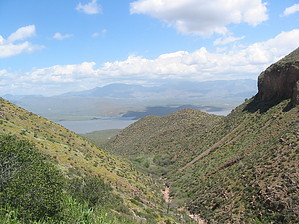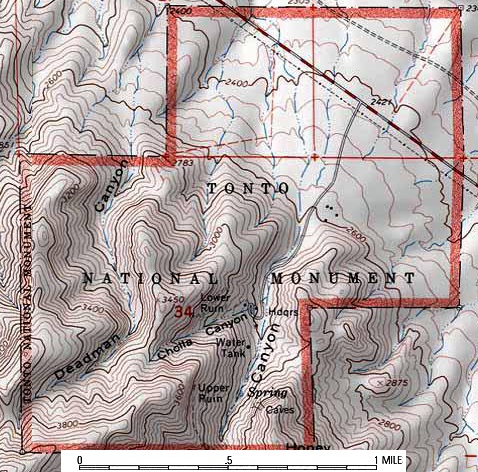| Guide | ♦ | 39 Triplogs | 0 Topics |
details | drive | permit | forecast | 🔥 route |
stats |
photos | triplogs | topics | location |
| 313 | 39 | 0 |
Great NPS guided hike to ruins by Randal_Schulhauser  A recent trip to the Tonto National Monument opened the prospect of visiting the upper cliff dwellings. Unlike the "open access" policy for the lower cliff dwellings, reservations for the guided visit to the upper cliff dwellings are required. Tours are restricted to 15 people or less, and begin at 10 am sharp! There is only 1 tour per day. Start the process by calling the NPS office at 928.467.2241 between 8 am and 5 pm (open daily). The earliest weekend tour I could arrange was within 3 weeks. A hiking tour confirmation letter will arrive in the mail. Bring this letter with you as confirmation of your reservation! A recent trip to the Tonto National Monument opened the prospect of visiting the upper cliff dwellings. Unlike the "open access" policy for the lower cliff dwellings, reservations for the guided visit to the upper cliff dwellings are required. Tours are restricted to 15 people or less, and begin at 10 am sharp! There is only 1 tour per day. Start the process by calling the NPS office at 928.467.2241 between 8 am and 5 pm (open daily). The earliest weekend tour I could arrange was within 3 weeks. A hiking tour confirmation letter will arrive in the mail. Bring this letter with you as confirmation of your reservation!We departed from home at 7 am. Our trusty black steed made the trip from Ahwatukee to Tonto NM in about 2 1/2 hours, including our customary stop at Einstein's for coffee and a toasted chocolate chip bagel. Go to the visitor's center to sign in and pay the per person entrance fee. You will need to show your confirmation letter! If you need to pass some time before the hike, there are plenty of artifacts and interpretive history films on display at the visitor's center.
The trail follows a spring-fed creek bed. It is well maintained but has shifted its path a couple of times due to flooding earlier this year. Ranger Eddie explained that the artesian spring provides a year-round sustainable water source for our riparian system attracting all known species of animals from the Sonoran Desert. Infrared trip sensor cameras have captured this evidence, including mule deer, javelinas, black bears, and a recent group of 4 male mountain lions. The mountain lions were note-worthy because they happened to rest for the night beside the camera trip sensor and every time they swished their tail, a picture was taken. Ranger Eddie indicated that the photographic evidence is on display back at the visitor center. Once past the artesian spring source, the trail continues to follow a dry creek bed. Ranger Eddie displayed an encyclopedic knowledge of all flora and fauna, particularly pointing out plants used by the ancient Salado for sustenance, cooking spices, and medicine. We stopped on many occasions to sample the bounty of the Tonto Basin, much like the ancient Salado would have. Miner's lettuce and peppergrass could find a place at the local salad bar!  When the dry creek bed meets the southern boundary fence between the Tonto National Monument and National Forest land, we are at the hiking trail "half-way point". We can look back on the wash towards Lake Roosevelt to picture the terrain we've just covered. We can also look up to get our first view of the upper ruins. When the dry creek bed meets the southern boundary fence between the Tonto National Monument and National Forest land, we are at the hiking trail "half-way point". We can look back on the wash towards Lake Roosevelt to picture the terrain we've just covered. We can also look up to get our first view of the upper ruins.The remainder of the hike to the ruins negotiates a series of switchbacks to climb about 450 ft in about 3/4 of a mile. Ranger Eddie provided plenty of breathers while continuing to point out plant life valued by the ancient Salado. We continue our assent with our goal continuously in sight. The spring flowers are said to be upon the wane, but I'm not convinced.  We reach the maximum elevation of 3390ft as evident by the 1940 geological survey marker, but another locked gate separates us from the upper ruins. Ranger Eddie has the key and we gain entrance to the extremely well preserved archeological site. I counted in excess of 20 mano and metate used to grind corn, beans, seeds and nuts. There are countless hand-painted pottery shards throughout the site. The ancient Salado constructed a basin to contain the water from a local seep for a convenient supply. Many of the 2nd story floors are still intact and the construction technique is evident. The upper cliff dwellings have at least 32 ground floor rooms, eight with a 2nd story. New rooms are constantly being discovered, some exposed by rainfall erosion, others by a Ranger suddenly crashing through what was thought to be a solid ground floor. This actually happened in 1996, leading to an emergency excavation of two northerly rooms. We reach the maximum elevation of 3390ft as evident by the 1940 geological survey marker, but another locked gate separates us from the upper ruins. Ranger Eddie has the key and we gain entrance to the extremely well preserved archeological site. I counted in excess of 20 mano and metate used to grind corn, beans, seeds and nuts. There are countless hand-painted pottery shards throughout the site. The ancient Salado constructed a basin to contain the water from a local seep for a convenient supply. Many of the 2nd story floors are still intact and the construction technique is evident. The upper cliff dwellings have at least 32 ground floor rooms, eight with a 2nd story. New rooms are constantly being discovered, some exposed by rainfall erosion, others by a Ranger suddenly crashing through what was thought to be a solid ground floor. This actually happened in 1996, leading to an emergency excavation of two northerly rooms.Ranger Eddie shared his thoughts on many recent archeological finds in the Tonto Basin that he believes will reshape conventional thinking about the habitation and abandonment of sites such as the Tonto Upper Cliff Dwellings. I won't delve into them here, but encourage you to find out for yourself by arranging your own guided hiking tour to this site. Enjoy! Gate Policy: If a gate is closed upon arrival, leave it closed after you go through. If it is open, leave it open. Leaving a closed gate open may put cattle in danger. Closing an open gate may cut them off from water. Please be respectful, leave gates as found. The exception is signage on the gate directing you otherwise.
Tonto NM NPS Details Well-preserved cliff dwellings were occupied by the Salado culture during the 13th, 14th, and early 15th centuries. The people farmed in the Salt River Valley and supplemented their diet by hunting and gathering native wildlife and plants. The Salado were fine craftsmen, producing some of the most exquisite polychrome pottery and intricately woven textiles to be found in the Southwest. Many of these objects are on display in the Visitor Center museum. The monument is located in the Upper Sonoran ecosystem, known primarily for its characteristic saguaro cactus. Other common plants include: cholla, prickly pear, hedgehog, and barrel cactus (blooming April through June); yucca, sotol, and agave; creosote bush and ocotillo; palo verde and mesquite trees; an amazing variety of colorful wild flowers (February through March); and a lush riparian area which supports large Arizona black walnut, sycamore, and hackberry trees. Check out the Official Route and Triplogs. Leave No Trace and +Add a Triplog after your hike to support this local community. | |||||||||||||||||||||||||||||||||||||||||||||||||||||||||||||||||||||||||||||||||||||||||||||||||||||||||||||||||||||||||||||||
 Route Editor
Route Editor





